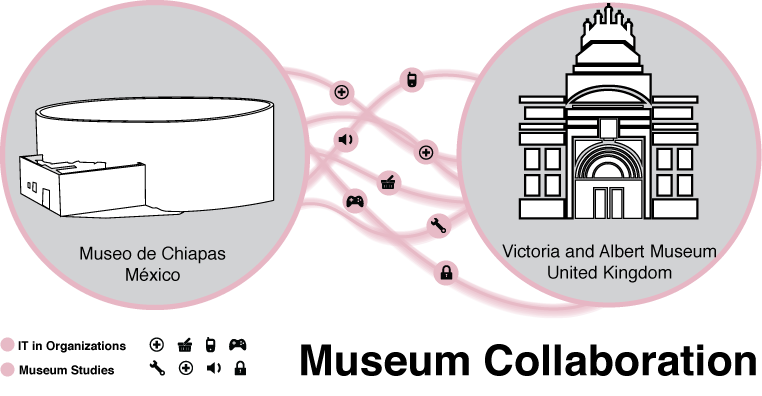Archive for the ‘web’ tag
Marketing Management Philosophies – New Economy – Information Bussinesses no comments
Marketing is a social and manager process whereby individuals and groups obtain what they need and want through creating and exchanging products and values with others. There are five alternative concepts under which organisations conduct their activities, the so-called marketing management philosophies: the production, product, selling, marketing and societal concepts. The production concept holds that consumers favour products that are available and highly affordable; management’s task is to improve production efficiency and bring down prices. The product concept holds that consumers favour products that offer the most in quality, performance and innovative features; thus, little promotional effort is required. The selling concept holds that consumers will not buy enough of the organisation’s products unless it undertakes a large-scale selling and promotion effort. The societal marketing concept holds that generating customer satisfaction and long-run societal well-being are the keys to both achieving the company’s goals and fulfilling its responsibilities.
Most successful and well-known companies have adopted the marketing concept, according to which achieving organisational goals depends on determining the needs and wants of target markets and delivering the desired satisfaction more effectively and efficiently than competitors do. Implementing the marketing concept often means more than simply responding to customers’ stated desires and obvious needs. Customer-driven companies research customers to learn about their desires, gather new product and service ideas, and test proposed product improvements.
The explosive growth in connecting technologies has created a New Economy which provides marketers with new ways to learn about and track customers as well as create product and services tailored to meet customer’s needs. Marketers have redefined how they connect with their customers; in contrast with yesterday’s companies that focused on mass markets, today’s companies are selecting their customers more carefully and developing more lasting and direct relationships with them. Web seems to enable customer relationship building as companies can demonstrate the abovementioned marketing concept on their web sites by including features that are important to consumers; online companies have moved from mass marketing to segmented marketing or one-to-one marketing, in which they target carefully chosen individual buyers.
The New Economy revolves around information businesses; information has the advantages of being easy to differentiate, customize, personalise and dispatch at incredible speeds over networks. With rapid advances in connecting technologies companies have grown skilled in gathering information about individual customers and more adept at individualising their products. Marketing companies go to great lengths to learn about and understand their customers’ needs, wants and demands; they build extensive customer databases containing rich information on individual customer preferences and purchases and then they mine these databases to gain insight by which they ‘mass-customise’ their offerings to deliver greater value to individual buyers. Web enables consumers and companies to access and share an unprecedented amount of information with just a few mouse clicks. In order to be competitive in today’s new marketplace, companies should adopt web technologies or risk being left behind.
**************
Armstrong, G. & Kotler, P. (2003) Marketing: An Introduction. New Jersey: Pearson Education Ltd
Drummond, G. & Ensor, J. (2005) Introduction to Marketing Concepts. Oxford: Elsevier Butterworth – Heineman
Kotler, P., Armstrong, G., Saunders, J., Wong, V. (2001) Principles of Marketing. New Jersey: Pearson Education Ltd
Palmer, A. (2012) Introduction to Marketing: Theory and Practice. Oxford University Press
Masterson, R. & Pickton, D. (2010) Marketing: An Introduction. London: SAGE Publication Ltd
Introductions: Technoethics no comments
Moor on Ethics & Technology
Moor (2005) believed that with an increase in the social impact of technological advances, the number of ethical challenges also increase. He suggested that this is a result of the ever-increasing novel uses of technological advances and a lack of ethical inquiry into these activities. For example, the Web has fundamentally altered the social contexts within which we live, work and play. It has raised several questions including some about the legitimacy of human relationships maintained using its platform, its facilitation of illegal activity on a large scale and the privacy of its users.
However, though these are very present and pressing societal issues, they are also vast areas for investigation, and there is relatively sparse research coverage. Also, an added dimension to this challenge is that technological advances seem to continuously change the standard ethical questions. Thereby researchers are forced to simultaneously attempt to explore the ethical implications of these technologies as they were, are now and could be in the future.
Technoethics: Tackling New Types of Ethical Questions
Unsurprisingly, many of the current debates surrounding technological advancement are addressed by technoethics (TE). They are some of the most challenging issues that scientists, innovators and technologists will face. These challenges usually characterise the roles these individuals play when plotting an ambitious route for the future. They inadvertently raise important questions about rights, privacy, responsibility and risk that must be adequately answered.
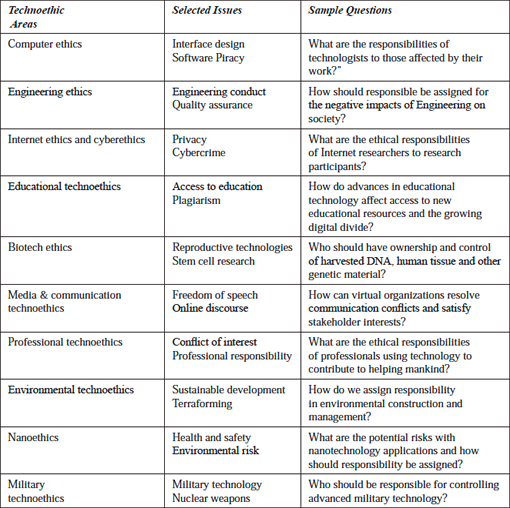
However, due to the variety of questions resulting in as much ethical inquiries that are based in different fields, there is a tendency for this knowledge to be somewhat disconnected. TE pulls this knowledge together around the central idea of technology. Moreover, unlike traditional applied ethics where focus is placed on an ethical concern for living things, TE is ‘biotechno-centric’. As the Web is to Web science, technology, as well as living things, are central in TE.
The Technoethics Way
Tracing its origins back to the late 1970s, TE emerged as an interdisciplinary field tasked with the job of answering the difficult questions posed earlier. Coined by Mario Bunge (1977), TE does not only assign technical responsibility to technologists but also gives them social and moral responsibility for their technological innovations and applications. It is believed that technologists are responsible for ensuring that their technologies are optimally efficient, not harmful and that its benefits are lasting.
This field distinguishes itself from other branches of applied ethics by elevating technology to the level of living things. However, it also builds on knowledge from wider ethical inquiry as well. TE has many sub-areas, for example, Internet, computer, biotech, cyber and nano ethics.
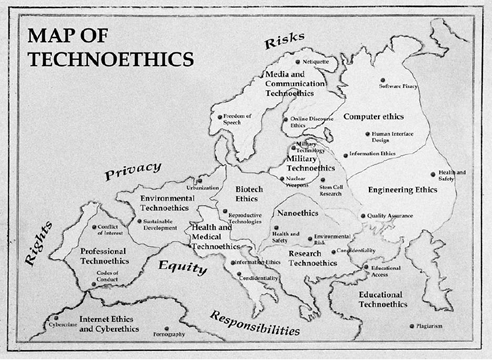
Calling All Web Scientists
Since the Web’s creation years ago, an understanding of this ever-changing phenomenon and its impact has been developing at a rapid pace in many disciplines. Yet there is a great deal more to learn, especially when the Web is positioned as the subject of focus. Considering Bunge’s views on technoethics, I believe that this obligation rests with Web scientists who are technically, morally and socially responsible for Web innovations and applications.

As a budding Web scientist, thinking about how technoethics applies to Web science, I am absolutely fascinated by all the very interesting questions that could be asked and that I could work towards answering. Ultimately, for us Web scientists, the aims of technoethics could be achieved by gaining insight into the relationship between people, the society and the Web, and how these entities impact each other.
Notes
This & Last Week’s Plan
Identifying the simplest books to read that will give an easy to understand introduction to the disciplines I picked.Making notes on books read.Prepare a blog post that gives an overview of what I want to work on.Publish a blog post that introduces technoethics.- Publish a blog post that introduces risk management.
Outline a reading plan for moving forward.
Introductory Readings
Ethics: A Very Short Introduction– Simon BlackburnHandbook fo Research on Technoethics– Rocci Luppicini & Rebecca AdellRisk: A Very Short Introduction– Baruch FischhoffFundamentals of Risk Management Understanding, Evaluating and Implementing Effective Risk Management– Paul Hopkin
Technoethics & Risk Management: Embracing The Web In The Workplace no comments

For some time I have been very interested in how people use the Web at work and the discussions surrounding this practice at different levels in the organisation. Over the years many have talked, written and passionately lobbied about the many issues that have emerged. I also joined this discussion and tried to present a balanced argument for the Web in the workplace, even if only for personal use. Yet, there still seems to be some confusion about how to best manage Web usage in organisations.
Taming the Web in the Caribbean Workplace
In the Caribbean, there is a predominantly negative perception of Web usage at work, especially among the management of large established organisations. There is a very real fear that Web usage in the workplace makes the organisation vulnerable to taking legal liability for related unlawful activities, security breaches, bandwidth drain and productivity losses. As a result, many organisations in the region have adopted an approach where they rather be safe than sorry. Unfortunately, based on my experience, measures used to manage risk are then usually excessive and outweigh the amount of risk posed.
Organisations have attempted to manage employee Web usage utilising several methods. Sometimes blocking and or requiring written permission to access certain sites and services, using monitoring software to enforce strict policies and providing training to employees on ‘proper’ Web usage in the workplace. However, barriers to unrestricted access are quickly being removed with the introduction of affordable 4G mobile Internet access and very strong adoption of smart phones (e.g., iPhone and Blackberry) by employees in the region. Unsurprisingly, this has prompted some organisations to respond by taking an even tougher approach to managing Web usage in the workplace on any device.
My Lens: Finding Responsible Ways to Embrace the Web in the Workplace
The above scenario, though somewhat extreme, does not only exist in the Caribbean region but is also likely to be present in organisations all over the world in varying forms. Given this, I have chosen to explore the disciplines of technoethics and risk management and their inherent approaches to the current issue. There is also hope to discover new ways organisations can go about creating effective strategies to encourage employees to use the Web at work in more responsible ways that does not put the organisation, themselves and the Web at risk.
Notes
This & Last Week’s Plan
Identify the simplest books to read that will give an easy to understand introduction to the disciplines you picked.- Make notes on books read.
Even if it is the last thing you do, prepare a blog post that gives an overview of what you want to work on by Monday.- Publish a blog post that introduces technoethics.
- Publish a blog post that introduces risk management.
- Outline a reading plan for moving forward.
Current Readings
- Ethics: A Very Short Introduction – Simon Blackburn
- Handbook of Research on Technoethics – Rocci Luppicini & Rebecca Adell
- Risk: A Very Short Introduction – Baruch Fischhoff
- Fundamentals of Risk Management Understanding, Evaluating and Implementing Effective Risk Management – Paul Hopkin
Perspectives of Psychology and Marketing on the issue of Self-disclosure on the Web no comments
The opportunities that marketers are provided with in cyberspace have led them to seek means to facilitate a two-way communication with consumers aiming at building a relationship of trust with them. Given that marketing is much broader than selling as it encompasses the entire business seen from the point of view of its final result, that is, from the customer’s point of view, the ability of marketers to glean the types of information needed often depends on consumer’s willingness to volunteer such information.
This essay aims to examine to what extent consumers’ behaviour in cyberspace differs from the ‘real-world’ behaviour and whether concerns about privacy as well as scepticism about how marketers use data prevent consumers from disclosing personal information. The fact that marketing is based on the study of the psychological characteristics of consumers who engage in voluntary self-disclosure, combined with the application of psychological theories and techniques to marketing, indicate the close relationship between these two disciplines.
In order to unfold the different approaches on the abovementioned issue, I decided to first get myself familiar with the basic concepts and techniques of psychology. Psychology is both an applied and academic field that studies the human mind and behaviour. Research in psychology seeks to describe human thought and behaviour, explain why these behaviours occur, predict how, why and when these behaviours will occur again in the future and modify and improve behaviours to better the lives of individuals and society as a whole. There are three types of research methods, causal, descriptive and rational, while psychologists use a range of techniques including naturalistic observation, experiments, case studies and questionnaires. Topics and questions in psychology can be looked at in a number of different ways; some of the major perspectives in psychology include the biological, cognitive, behavioural, evolutionary, humanistic perspective.
Given that the web has created a new type of society where the presence of other human beings is implied rather than actual, I particularly focused my interest on the discipline of Social Psychology which aims to understand and explain the impact of the social environment on the thought, feeling and behaviour of individuals. A basic concept of social psychology that describes our everyday interactions is the concept of self-disclosure which is defined as ‘the voluntary making available of information about one’s self that would not ordinarily be accessible to the other at that moment.’
Self-disclosure has received considerable attention from consumer psychologists as it plays a vital role in relationship development and maintenance. Although self-disclosure research has shown that people are reluctant to divulge information about themselves, one notable exception to this rule involves the norm of reciprocity which refers to the tendency for recipients to match the level of intimacy in the disclosure they return with the level of intimacy in the disclosure they receive; people are more likely to engage in self-disclosure if they first become the recipients of such disclosures from their conversational partners. A few researchers have suggested that consumers interact with the source of electronic communications in the same way they interact with other people; therefore reciprocity could make consumers more involved in self-disclosure even in cyberspace. Thus, theoretically, in order to trigger the reciprocity principle, a company would first have to reveal some information about itself to the consumer.
Botha, B., Strydom, J., Brink, A. (2004) Introduction to Marketing. South Africa: Juta and Co Ltd
Cialdini, R. B. (1993). Influence: Science and practice. New York: HarperCollins.
Derlega,V. J.,& Chaikin, A. L. (1977). ‘Privacy and self-disclosure in social relationships’. Journal of Social Issues, 33, pp. 102–115
Gross, R. (2010) Psychology: The Science of Mind and Behaviour. London: Hodder Education
Hill, C. T., & Stull, D. E. (1982). ‘Disclosure reciprocity: Conceptual and measurement
Issues’. Social Psychology Quarterly, 45, pp. 238-244
Holtgraves,T. (1990). The language of self-disclosure. In H. Giles & W. P. Robinson (Eds.), Handbook of language and social psychology. Chichester, U.K.: John Wiley
Joinson, A.N. (2001). ‘Self-disclosure in computer-mediated communication: The role of selfawareness and visual anonymity’. European Journal of Social Psychology, 31, pp. 177–192
Economics of Ontologies no comments
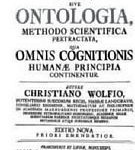 Am trying to focus back in on my original assertion about what I was going to study. This was whether there are differences between subjects and their degree of separation from the www, and their primary ontologies. Although I was going to use economics and psychology or perhaps sociology and their attendant ontologies to create a spotlight with which to examine this question, this would still involve looking at the ontologies of a range of other subjects.
Am trying to focus back in on my original assertion about what I was going to study. This was whether there are differences between subjects and their degree of separation from the www, and their primary ontologies. Although I was going to use economics and psychology or perhaps sociology and their attendant ontologies to create a spotlight with which to examine this question, this would still involve looking at the ontologies of a range of other subjects.
I was going to use economics as a focus, as I think it perhaps represents something that might be wrong with how we talk about knowledge in general and reasons for studying, working together, collaborating – ultimately: trust.
A lot of work that we do is tied into research programs that are underwritten by governments as being part of some economic promise. For example, the last Labour government’s education policy was predicated partly on the premise (stemming from research in the 1950s that re-emerged in the 1970s (need to find and cite)) that countries with a more highly educated population tend to do better economically. Thus following Tomlinson’s recommendations, the Diploma system was introduced, only partially, which in fact had the consequence of introducing a system that did the opposite of what he had intended.
This however, being loosely accepted: that the more highly educated a population is, the more wealthy their country, it would seem to follow that it makes sense to make use of emerging technologies to help to educate this population. There is a body of research on this – how technology can be ubiquitous; it can get to the places that teachers can’t, and can help to make learning something that is always ‘on’.
There are actually so many problems with these assertions that it would take a whole other blog post, or perhaps even, essay, or perhaps even, thesis to go into them – but I’m happy to accept that 1) learning is basically a Good Thing and that 2) technology can help to mediate it. I might perhaps then reluctantly accept that it’s possible that if you have a lot of learning, you might end up creating more wealth for your country, however some of the data for this is possibly correlative rather than strongly causal.
But to get back to my original question, it is whether there might be said to be an economics of ontologies? Could we find out whether there are some subjects that lend themselves, via their objects of knowledge to be shared and studied on the web? And that therefore are more accessible and therefore might end up generating more money?
It seems at first glance, that physics might be one of these subjects. Physics research can be large scale and tend to be carried out by large communities who share resources. Is there something about the nature of physics that makes people more likely to collaborate? Are they perhaps true seekers after knowledge who are less motivated by economics / reward than say, chemists? (Apologies to all you pioneering, truth-seeking chemists out there.) Would this then mean that by the very nature of a subject, if it attracts more people who care more about discovery, or truth, then they may well as a result, collaborate more, and could easily use technology in order to do this, but they care less about creating wealth, so that all web-based subjects that can easily or practically use the web to be studied are never going to be worth funding by governments who only care about short-term goals?
This seems on the face of it, rather facile, but it does intersect with another debate about why there still seem to be less girls studying physics, and in general, science subjects. (This debate appears worldwide, but I shall for now confine myself to the UK.) There was recently some speculation about whether the Big Bang Theory was attracting more people to the subject, but this generated some scathing responses from researchers who had determined that take up of physics was in fact governed by early influences.
06 – Museology no comments
Museum Studies
The museums by themselves have different processes and meanings for the population and institutions. Through these classifications of museums, we can provide a more accurate linkage in between the object of study (or exhibited) and the audience.
Cultural Theory
Through contemporary cultural theory we can incorporate all sort of art practices into the everyday life. This will create our culture. So culture is becoming something less separatist in which art or culture itself no longer belongs to the educated or rich classes. The cultural theory is now being implemented more and more within museums, specially in social history and contemporary collections (Macdondald, 2011). Contemporary cultural theory seeks to utilize culture from a pluralistic perspective.
We inhabit a culture in the sense that we share a certain amount of knowledge and understanding about our environment with others.
We have evolved into a society that shares what Stuart Hall (1997: 18) in Macdonald (2011:18) defines “cultural maps” which makes us question or make judgements the value, status and legitimacy of products or cultural practices.
Within museums we are trying to materialize values and trying to give meaning to objects. For this reason museums within cultural theory are public spaces in which their values and the culture creation is always under debate.
Main theoretical apporach
In order to give meaning to something, we depend on a social construction of a signifying system that creates a shared understanding. The semiotic research of Ferdinand de Saussure, indicates that signifiers and signifieds relate arbitrarily. This means that perhaps the meaning or classification (curation) system to an object could be completely different from the perspective of a different culture.
When an artifact is being curated, this is attached or linked to an interpretation system that could be attached to a single cultural ‘string’. Taking the post-structuralist approach, we can provide a structure of interpretation that adapts to the cultural needs of the artifact or the audience. The attempt to materialize culture and present how an object can change through time, tends to fit to the vision of the post-structuralist thinking.
For this project this could be the way in which post-structuralism becomes the main way of presenting an object of study. A multi curated object presented from different cultural backgrounds and within different cultural audiences. Although the object can be presented with several meanings, “poststructuralist theory does not automatically imply that the material world ceases to exist” (Macdonald, 2011:21), but it will be understood from different perspectives or meanings.

V&A Mark Lane Archway (Gallery 49)
The Object
Before photography, multimedia and all the new technologies, the object by itself was the way to present the culture or places which it came from. For this reason I think that the object presented should contain enough information to communicate or represent the specific qualities of a culture. When the object is unique it will be a challenge to transmit the embedded information to a replica that could be presented somewhere else. The use of modern manufacture technology and prototype making can assist with this process. But it will be the correct adaptation of the object and its environment what will be able to make the correct communication to the audience possible.
Bibliography
MACDONALD, S. 2011. A companion to museum studies, Malden, MA ; Oxford, Wiley-Blackwell.
PEARCE, S. 2001. Interpreting Objects and Collections, Andover, Routledge, 2001.
05 – Information Systems no comments
Information Systems
O’brien (2007) defines an Information system (IS) as any kind of organized combination of people, hardware, software, communications network, data resources, and policies and procedures that stores, retrieves, transforms, and disseminates information in an organization.
The Framework.
There are 5 main areas that build the framework for the information systems. All these elements play an important role in the process of building the research project.
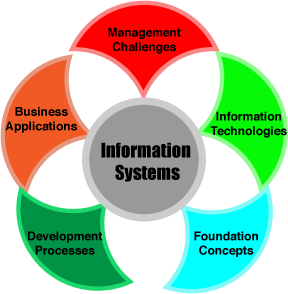
Foundation Concepts
To develop an information system, it is important to understand the behavioral, technical, business and managerial elements in order to develop the components for the Information System.
Information Technologies
In this area we will focus on the hardware, software, networks and data management that will affect the project in regard of its development, concept development and management.
Business Applications
Concepts like e-commerce can influence or provide ways of how the management can be implemented in an Information System like the one required for the Museum application.
Developments Processes
This will be focusing on the planning, development and implementation of the system(s) to meet the requirements of the problem or situation.
Management Challenges
Through this process, we will focus on delivering and managing effectively the information technologies at the end-user, business or int this case a multiuser/global institution.
Inside Management Systems
There are several types of Information Systems. They are usually classified into two different groups: Operations Support Systems and Management Support Systems.
Operation Support Systems:
- Specialized Processing Systems
- Transaction Processing Systems
- Process Control Systems
- Enterprise Collaboration Systems
Management Support Systems:
- Management Information Systems
- Decision Support Systems
- Executive Information Systems
- Specialized Processing Systems
There are five major resources focusing on the relationship with the IS and the products (O’brien, 2007)
- People Resources
- Specialists – software developers or system operators
- End Users – the person who uses the IS
- Hardware Resources
- Machines – computers, monitors, drives, printers or scanners
- Media – Storage, disks or paper forms
- Software Resources
- Programs – operating systems, editors or payroll applications
- Procedures – data entry procedures, error correction, paycheck distribution procedures
- Data Resources
- Communication media, communication processors, network access, control software
- Information Products
- Management reports, business visual display and paper forms
All these elements and areas can help us to visualize the complexity of the development of an Information System. We need to know what do we want from the organisation (system) to do? An organisation that includes people is more complex to manage than one that doesn’t (Wilson, 2001). For this, it is important to analyse the system implemented. Users or a human response will vary which will vary the judgement of the system.
To avoid judging problems we have to follow a specific methodology. We have to define a problem first of all. From here we can start gathering the appropriate techniques to solve this problem. The implementation or application of these techniques will allow us to go to the next step if effective or back to the previous one if unsuccessful. We also have to analyse the cost/effective solution. After these steps we can finally implement the solution.
So we have to solve a problem. But, who is defining the problem. What seems to be problematic for one person can not appar to be so for another one. Wilson (2001) explains that instead of focusing on a person’s problem or a problem, we have to focus on defining a situation that is problematic. I believe this will help the project not to isolate on a single person’s perspective.
Bibliography
O’BRIEN, J. A. & MARAKAS, G. M. 2007. Introduction to information systems, Boston, Mass., McGraw-Hill.
WILSON, B. B. 2001. Soft systems methodology conceptual model building and its contribution, Chichester ;, Wiley,.
04 – IT Modelling / Reporting Experiments (Statistics) no comments
Hypothesis and Experimentation
The scientific method
The hypothetico-deductive aspect of the scientific method focuses on the observation. This observation leads to a guess or logical guess called the hypothesis that tries to explain how a system works. From there, some predictions are made from this hypothesis and the experimentation or tests begin to try to prove it.
After the experimentation, the results can only be either consistent or inconsistent with the hypothesis.
These sets of experimentation will allow the hypothesis to be more consistent with the implementation of the project. But it is important to link the results properly with the hypothesis. This is where the statistics come in.
Statistics
Statistics are use in many different industries. Statistics will allow us to make decisions about large numbers of subjects which we can be able to group into some sort of systems. This way we can see patterns or data that is not visible through ‘static’ numbers.
It is extremely important to understand how statistics work. This is due to the necessity to analyse the information inside them. If we can not produce a proper statistical model, perhaps we won’t be able to make a good decision about our project. Also, if we can not understand statistics, there is no way we can see errors or disprove a theory or result.
Graphs
Once we have developed the statistical models we also have the option of visualizing this data. Or perhaps analyzing more in depth the information provided.
Mean, Error, Percent Error, and Percent Deviation
All these arithmetical/statistical tools can help us to understand our data. For example the Percent Deviation will allow us to understand or to see the whole extent of the data, not only the mean number.
| σ = |
|
Percent Deviation |
All statistical models are methods of obtaining the probability of success of our experiments which will help making a decision about our hypothesis or group analysis
Reporting Experiments
Through the report is where the explanation about the study. Peter Harris (2008) points 5 elemental items for the report.
- What you did
- Why you did it
- How you did it
- What were your findings
- What do you think it shows
This can then be translated to a formal document presentation like this:
- Title
- Abstract
- Introduction
- Method
- Results
- Discussion
- References
- Appendices
So, through this report we are intended to provide the information and the appropriate material. For this we also have to consider our reader. Who is intended to see our information. This is important because perhaps we will have to give an introduction to our area of study. If we are presenting the document to Computer Scientists, perhaps we need to give and induction to Heritage or Visual Communication.
Within museums
The statistics and the report provided is also an intrinsic part of the analysis. Before even starting to provide model experimentation, it is important to provide a hypothesis. Something like:
- What are the main reasons why small museums don’t have access to big collections?
- How many visitors does each museum have per year/per day/per month?
- How many times does an expensive collection travel through different museums?
It is important to start analyzing this type of information in order to visualize the real requirements not only of the project but also of the museum. problem or situation.
Bibliography
Brookshear, J. G. (2010). Computer science an overview. (11th ed.). Addison-Wesley,.
Harris, P. (Peter R. ). (2008). Designing and reporting experiments in psychology (3rd ed., p. 284). Maidenhead :: Open University Press,
McKillup, S. (2006). Statistics explained an introductory guide for life sciences (p. 267). Cambridge :: Cambridge University Press
03 – Museum collaboration // Collaborative Projects no comments
Collaborating with other disciplines
Starting from the essential bibliography for this research, there are some elemental concepts that the readings from Frederick Brooks (1995), Peter Harris (2008) and Brian Wilson (2001). The methodological process to undertake this project will be very important. The interdisciplinary quality will bring big challenges in the managerial aspect of the project. At this early stage, I believe the project being an intrinsic part of Web Science will invite collaborative work from Computer Science, Museology, Business Management and Visual Communication among others.
Developing Software?
I will argue that the project will contain a product similar to a computer software product. This product I believe will be develop similar to software, by this I mean a “collection of programs and the algorithms they represent” (Brookshear, 2010).
The complexity within the development of any kind of software of application requires an understanding of the methodology and the environment in which these products are created. It is also important to learn how to communicate with the team and how to make the team communicate with each other as a managerial task (Brooks, 1995). In the development of software, Brooks (1995) defines some essential tasks:
- Planning
- Coding
- Component test and early system test
- System test, all components in hand
Its about time!
It is important to know how to calculate the time needed for the development of the project and the time needed for each one of the tasks, not only for the implementation of these digital tools, but also for all the research tasks of the project. If there are some ‘hold backs’ within the project, Brooks (1995) explains that bringing more man work will not only be the solutions due to the tasks required for the development of software. Therefore it is important to analyse and understand all the different solutions applied within the Computer Science discipline and all the other disciplines involved.
It is recommended to use as little people as possible for the construction of a ‘soft system’. This is due to the managerial problems that big teams create. But sometimes small teams won’t be able to cope with the workload. Based on this, I will argue that it is also important to plan correctly the size of the teams in order for the research project to flow smoothly and with minimum communicative problems.
Assembling the team
It is my perception that is important to understand how a big system team is built in order to continue or to blend the methodological process into that work structure.
Although there are other organizational proposals, the one that seems more traditional is where we find a chief programmer defining the original program and codes and even testing the software. Followed by a co-pilot working as a second hand. There are other team members like the administrator, the editor, secretaries, program clerk, toolsmith, language lawyer and the tester (Brooks, 1995).
Problem solving
The main objective of a program or software is to solve a problem (Brooks, 1995; Wilson, 2001; Harris, 2008). For this it is essential to define the problem. What is this set of tools or applications going to solve. Wilson (2001), defines two types of problems: hard problems and soft problems. “The design of a piece of software to meet a given specification is a hard problem (as long as the specification is ‘a given’) whereas the specification of information requirements to meet business needs is a soft problem…”. The perception of what is a problems is also important. Being a multidisciplinary project means that what seems to be a problem, it could not mean anything to the person working in the museum or the audience or even the cultural heritage manager. To solve this, Wilson (2001) suggest that instead of trying to solve a problem, it would be more helpful to try to solve the situation that is creating the problem. For this he proposes the next methodology.
- Define the situation that is problematic
- Express the situation (top mapping, rich picture, etc.)
- Select concepts that may be relevant
- Assemble concepts into an intellectual structure
- Use this structure to explore the situation
- Define changes to the situation (i.e problems to be tackled)
- Implement change processes
Its all about the good manners.

Both Wilson (2001) and Brooks (1995) express the importance of the way to communicate with other team members. The ‘hierarchical’ level of communication. During the production of this research project (and any other), which I completely agree is to break the ‘tree’ system in which one person is the boss and the people below are reporting or working for this person. The responsibilities have been already defined and in the communicative structure, everybody is allowed to participate and to provide solutions to the situation problem solving.
Read the rest of this entry »
02 – Museum collaboration (bibliography) no comments
Museum collaboration // Essential bibliography
In this post I will start to list some of the bibliography to be used to get familiarized with essential concepts and ideas that will allow the project to be carried in the most optimal manner. The bibliography was chosen from the BSc Information Technology in Organizations fron University of Southampton and readings from Museum Studies and Museology.
Due to my visual communication background the Museum Studies readings I will be focusing on the more challenging theories instead on the basic methodology. On the other hand, IT in Organizations I will be focusing on basic readings to be able to get familiarized with basic concepts.
Information Technologies in Organizations
Tools and Techniques for IT Modeling
- Peter Harris. Designing and Reporting Experiments in Psychology (2nd ed). OU Press
- Steve McKillup. Statics Explained. Cambridge
Collaborative Projects
- Brooks, FP, The Mythical Man-Month, Addison-Wesley, 1982.
- Checkland, P, and Scholes, J, Soft Systems Methodology, Wiley
Human Computer Interaction
- Dix A, Finlay J, Abowd G and Beale R, Human-Computer Interaction, 3rd Edition. Prentice Hall, 2003
- Norman DA, The Design of Everyday Things, Basic Books, 2002 new edition
Information Systems Strategy
- Bocij, P. et al. (2005) Business Information Systems Technology, Development and Management in E-business. Pearson Higher Education FT Prentice Hall.
- Turban, E., Rainer, R.K. and Potter, R.E. 3rd editon (2004) Introduction to Information Technology: John Wiley and Sons
- Brown, J.S. and Duguid, P. (2002) The Social Life of Information. Harvard Business School
- Simon, J.C. (2000) Introduction to Information Systems. New York: Wiley
Museology and Museum Studies
- Sharon Macdonald. A Companion to Museum Studies, Malden, MA ; Oxford : Blackwell Pub., 2006
- Pearce, Susan. Interpreting Objects and Collections. Andover:Routledge, 2001
- Hein, George E. Learning in the Museum (Museum Meanings) Boulder, Co. netLibrary c2001-c2003
- Poli, C. Mobility and Environment: Humanists versus Engineers in Urban Policy and Professional Education. Dordrecht; New York, Springer c2011
